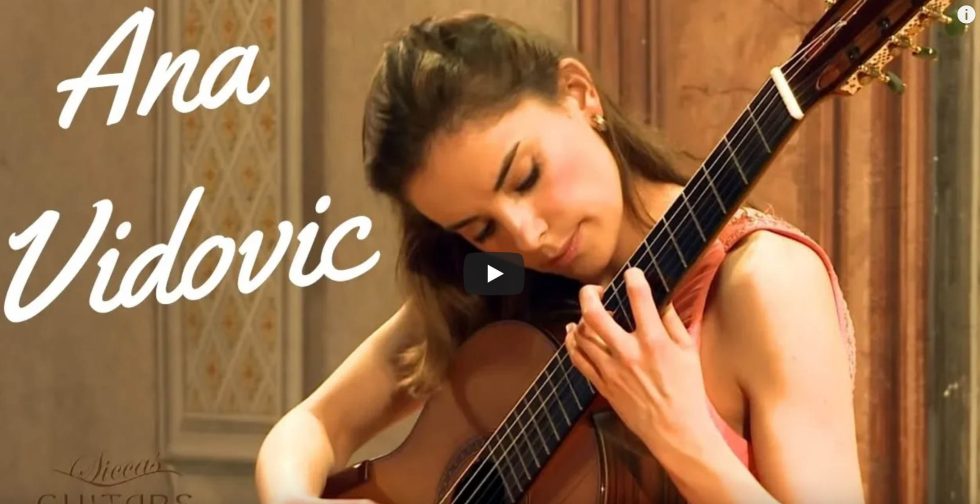
The Timeless Elegance of Asturias (Leyenda) by Isaac Albéniz
“Asturias (Leyenda)” by Isaac Albéniz is one of the most recognizable and beloved compositions in the classical guitar repertoire. Originally written for the piano, this piece has been famously transcribed for the guitar, where its unique flavor and dramatic intensity truly shine. A quintessential Spanish masterpiece, “Asturias” combines complex rhythms, emotive melodies, and technical challenges that captivate both performers and listeners.
At Siccas Guitars, we had the honor of recording this incredible piece with the renowned guitarist Ana Vidović, whose interpretation of “Asturias” showcases her masterful technique and expressive depth.
Historical Context and Origins
“Asturias” was originally composed as part of Isaac Albéniz’s Suite Española, Op. 47, a collection of eight pieces for piano, each reflecting the character of different Spanish regions. Despite its title, “Asturias” does not reflect the music of the Asturias region in northern Spain. Rather, its character aligns more closely with the flamenco traditions of Andalusia in southern Spain, particularly the style known as “cante jondo” (deep song) — a deeply emotional and expressive genre of flamenco singing.
Albéniz’s ability to infuse the essence of flamenco into his music makes “Asturias” a piece that resonates powerfully with the spirit of Spanish culture. The intricate rhythms and haunting melodies evoke images of Spanish landscapes and folklore.
The Guitar Arrangement
Although “Asturias” was written for the piano, it is on the guitar where this piece has found its true home. The most well-known transcription of “Asturias” was created by the legendary guitarist Andrés Segovia, who adapted the piano’s percussive and rhythmic elements into a dazzling guitar arrangement.
The composition is structured in A-B-A form:
- Section A: The opening is marked by fast arpeggios that create a sense of urgency and intensity. These rapid finger-picking sequences challenge the performer’s dexterity and precision.
- Section B: The middle section offers a softer, more lyrical contrast, showcasing the guitar’s ability to convey emotion through sustained, singing phrases.
- Section A (Reprise): The initial intensity returns in the final section, closing the piece with the same dramatic flair that began it.
For guitarists, “Asturias” is a tour de force of technical challenges, particularly in controlling the rapid alternation of the thumb (for the melody) and fingers (for the arpeggios). The piece also demands careful attention to dynamics, with its frequent shifts between fiery intensity and delicate expressiveness.
Ana Vidović’s Interpretation
Ana Vidović’s performance of “Asturias” is a perfect blend of technical prowess and emotional depth. Known for her flawless technique and captivating musicality, Vidović captures the essence of Albéniz’s composition while bringing her own interpretation to the piece. Her mastery of the tremolo and arpeggio techniques adds clarity to the intricate passages, and her dynamic control imbues the performance with a sense of storytelling.
In her rendition, Vidović transitions seamlessly between the fierce arpeggios of the A section and the gentle, evocative phrases of the B section, allowing listeners to feel the full range of emotions embedded in the music. You can experience this breathtaking performance here.
Technical Aspects and Challenges
“Asturias” presents several technical challenges that make it a popular choice among advanced classical guitarists:
- Fast Arpeggios: The opening and closing sections are marked by rapid arpeggios that require precision and speed. Maintaining evenness and clarity in these fast passages is key to creating the desired dramatic effect.
- Thumb and Finger Independence: The melody is often played with the thumb, while the arpeggios are played by the other fingers. This requires a high degree of independence between the thumb and fingers, demanding coordination and control.
- Dynamic Range: To capture the full emotional range of the piece, a guitarist must use subtle dynamic contrasts, switching between intense, aggressive playing and softer, more lyrical passages.
- Rhythmic Complexity: The rhythm of “Asturias” is intricate, influenced by flamenco’s syncopated beats. Performing the piece with rhythmic precision is crucial to conveying its flamenco roots.
The Cultural and Emotional Impact
“Asturias” is a piece that embodies the passion, mystery, and drama of Spain’s musical heritage. From the opening notes, the listener is transported to a world of fiery flamenco dancers, shadowy Andalusian courtyards, and echoing guitar strings. The driving rhythm and haunting melody create an atmosphere that is both intense and melancholic.
The emotional depth of “Asturias” makes it a favorite not only among performers but also among audiences worldwide. It is a piece that evokes a visceral response, leaving listeners in awe of the guitarist’s skill and the evocative power of the music.
Conclusion
Isaac Albéniz’s “Asturias (Leyenda)” is a masterpiece that transcends its origins as a piano composition to become one of the most iconic pieces for classical guitar. Its blend of technical difficulty, emotive power, and cultural significance makes it a must-learn piece for advanced guitarists.
At Siccas Guitars, we are proud to have captured Ana Vidović’s stunning performance of this timeless work. Her interpretation highlights both the technical brilliance and emotional depth that “Asturias” demands. Whether you’re a guitarist looking to tackle this challenging piece or a listener who simply wants to enjoy the beauty of Spanish classical music, “Asturias” is a piece that will leave a lasting impression.
Be sure to watch Ana Vidović’s brilliant performance of “Asturias” here:


















